Thucydides sent me to Melos. Mission accomplished, Hegemon.
We also went to an island. Ever since I read Lawrence Durrell’s The Greek Islands (London : Faber and Faber, 1978) that has been on my list. I choose Melos because I have read about it repeatedly in Thucydides’s History. If I had to choose one, and I did, I wanted it to be this one.
I booked ferry tickets from Piraeus to Melos on a web site. http://www.greekferries.gr/
And it worked out just fine, thanks in part to Eleni Louloudi who saw to it that the tickets were delivered to our hotel with an efficiency that compares to my experience of buying train tickets in Japan. I mean this as high praise. We rode on Hellenic Seaways 3, a smooth ride each way of about four hours with two stops on the way. It was a little less time on the way back and we got in early.
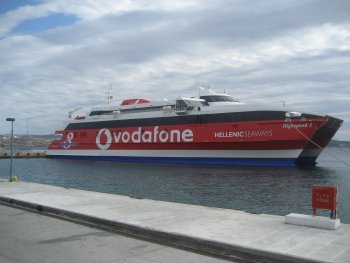
I had taken precautions against sea sickness, elastic bands on the wrists, as recommended by the chemist, but they were not put to the test.
Arriving back at Piraeus at 9.30 p.m. made me very glad I have booked a driver to pick us up. Piraeus is not a nice place anytime, still less encumbered by bags, in the night. Back to the Hotel Adrian by 10 p.m.
Melos is in the Sea of Crete due south of Athens. Check it out on google earth,
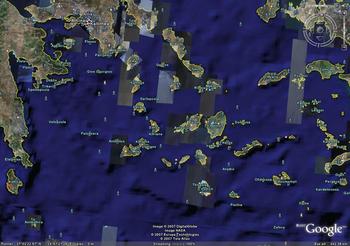
or see http://www.milostravel.com/
We stayed in the Hotel Portiani which was very nice indeed. Danae made us feel like family. http://www.hotelsofgreece.com/cyclades/milos/portiani/index.html
Once again we followed Matt Barrett’s sound advice.
We rented a car from Niko’s Cars at nchronis1@msn.com on the waterfront at Adamas and drove to the settlement of Plaka and around the island. In Plaka we visited the Archaeological Museum.
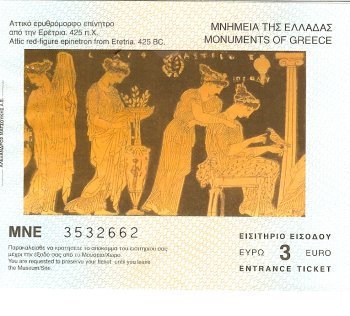
(By the way, this seems to be the standard ticket for many sites; we have the same stub from Marathon, Nemesis, and several other places. The one above is from Melos; I know because I write the location on the back of each one. Something about being obsessive.)
There I photographed this, the only reference to Thucydides I found on the island. Squint, it is there.
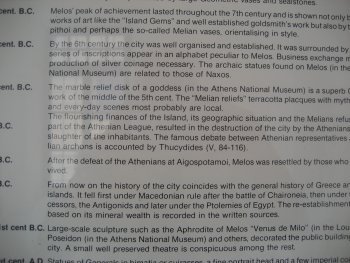
The Melian Dialogue is the most frequently cited part of his History, and it is usually mistakenly cited. On that I have commented in my ‘Cracking the Thucydides Code,’ Antioch Review, 65 (2007)1, 173-185. This link is to the abstract on the Review‘s homepage. http://review.antioch.edu/detail.php?id=815 I am sure your local library can find it for you. For his original text see Download file
We then climbed a great many goat steps over scree worse than that on the Acropolis on our own to the top of Kastro in Plaka. Plaka is near the site of the ancient settlement in the time of Thucydides. Later we went down to Klima the ancient sea port where Nicias and Alcibiades probably stepped ashore. This is a view from the Kastro to Klima, the foreshortening of the camera gives no idea of the height from which the picture was taken, but believe me it was high.
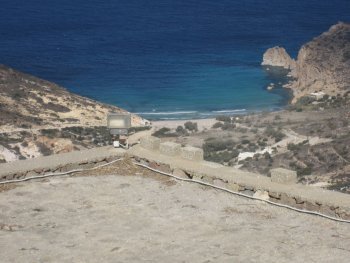
Klima is just out of the picture on the left. While we were climbing Kate asked who the Melians were that I should make this pilgrimage. On those goat steps I did not have the wind to answer, and I am still not sure what the short answer is. They were neutrals who tried to reason with the beast that democratic Athens had become in Thucydides’s telling of the slow moral rise and swift moral fall of Athens.
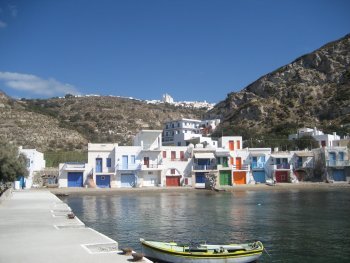
This Klima looking back toward Tripiti, the site of the settlement in 416 B.C. The Kastro is not visible from this view out on the end of the jetty. Cute and colourful I know.
We saw many tunnels on our excursions. The Germans occupied Melos during World War II and did a lot of tunnelling to store supplies for a long haul. All of his an more on wikipedia http://en.wikipedia.org/wiki/Melos
I picked up a pebble on the beach at Klima as my souvenir and it is now (properly labelled to be sure) on my desk. A white pebble the size of an ordinary mens wrist watch. Bland.
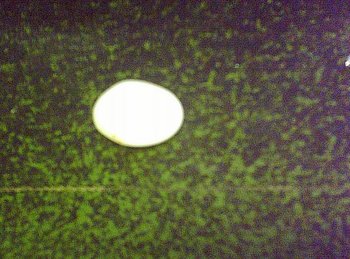
Melos also has a mining museum that somehow we did not get though we went past it on foot and in the car several times. I know obsidian was long mined there.
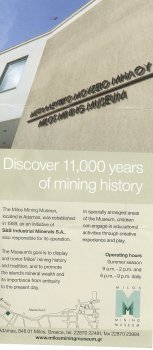
Maybe next time.
By the way, is it Milos, Melos, or Mylos? Same island, several spellings.
When we wondered through the streets of Plaka at the top of the hill, we also came across the Utopia Cafe which was closed for the season.
Outside the front door is a quotation from Thomas More.
Visiting this cafe will have to wait until next time.

Hi Michael,
you should give Cafe Utopia a second chance. It’s one of the most amazing places on Milos island for having an ouzo, frappé or something. 🙂
Best
Anne
>1) “No plan survives first contact with the enemy.”The actual quote, normally unattributed, that this simplistic drivel, used by every idiot who wouldn’t know how to unfold an entrenching tool but deigns to opine on affairs military, is much more complex and specific and not as definitive. The source is Moltke the Elder. Most people, even military folks, wouldn’t know him from a Molson Lager.“…no plan of operations extends with any certainty beyond the first cocatnt with the main hostile force.” You can find it in the book, Moltke On the Art of War by Daniel Hughes on page 92.2) “I divide my officers into four classes; the clever, the lazy, the industrious, and the stupid. Most often two of these qualities come together. The officers who are clever and industrious are fitted for the highest staff appointments. Those who are stupid and lazy make up around 90% of every army in the world, and they can be used for routine work. The man who is clever and lazy however is for the very highest command; he has the temperament and nerves to deal with all situations. But whoever is stupid and industrious is a menace and must be removed immediately!” This quote is frequently, and incorrectly, attributed to Generalfeldmarschall Erwin Rommel. The actual source is Generaloberst Kurt von Hammerstein-Equord, writing in 1933. An interesting guy to say the least. His wikipedia entry is quite good. Also posted at ON VIOLENCE.